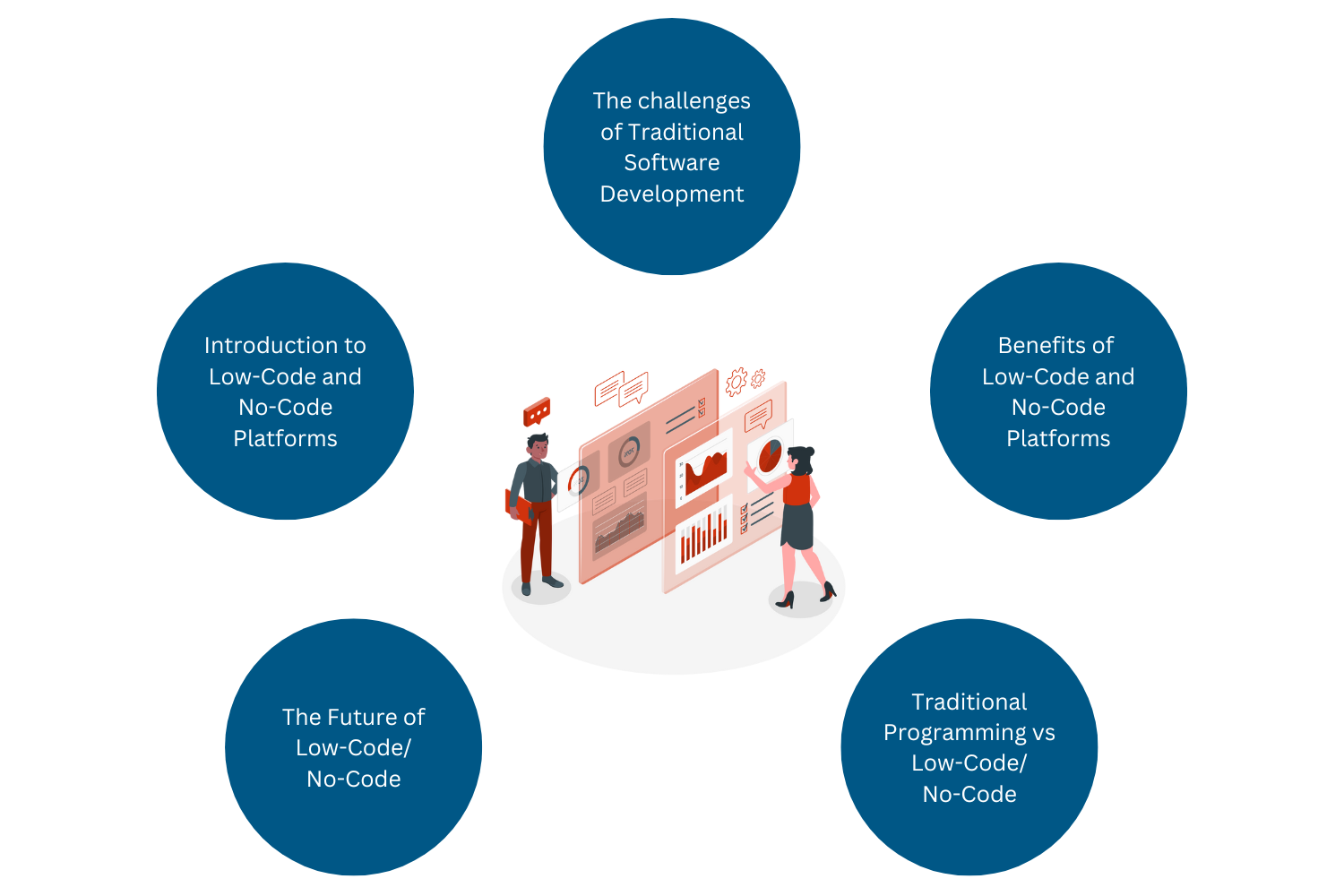Traditional software development has always been a domain of skilled developers who write complex code to build applications. This process involves various stages such as requirement analysis, design, implementation, testing, deployment, and maintenance. Each of these stages demands a significant investment of time, money, and specialized expertise. The traditional development approach is not only expensive but also time-consuming, leading to long development cycles and delayed time-to-market.
In contrast, low-code and no-code platforms have emerged as game-changers in the software development landscape. These platforms allow users to create applications with minimal hand-coding or no coding at all, using graphical interfaces and pre-built templates. They are designed to simplify and expedite the development process, making it accessible to a broader range of users, including those without traditional coding skills.
This blog aims to shed lights on:
- The challenges of Traditional Software Development
- Introduction to Low-Code and No-Code Platforms
- Benefits of Low-Code and No-Code Platforms
- Traditional Programming vs Low-Code/No-Code
- The Future of Low-Code/No-Code
The Challenges of Traditional Software Development

High Costs and Time-Consuming Nature
One of the most significant challenges of traditional software development is the high cost associated with hiring skilled developers and maintaining a development team. The process is inherently time-consuming, requiring meticulous planning, coding, testing, and debugging. This not only delays the launch of applications but also escalates costs due to prolonged development cycles.
Long Development Cycles and Delayed Time-to-Market
Traditional development involves a sequential process where each phase must be completed before moving on to the next. This waterfall approach can lead to long development cycles, making it difficult to respond quickly to market changes or customer feedback. Delays in time-to-market can result in missed opportunities and a competitive disadvantage.
Maintenance and Update Challenges
Once an application is deployed, it requires continuous maintenance and updates to address bugs, security vulnerabilities, and new feature requests. Traditional development teams often struggle with the backlog of maintenance tasks, further consuming resources and time. This ongoing need for maintenance can be a significant drain on an organization’s resources.
What are Low-Code and No-Code Platforms?
Definition and Differentiation
Low-code platforms provide a development environment that allows users to create applications with minimal coding. These platforms offer visual development tools, pre-built components, and integrations that simplify the coding process. Users can drag and drop elements to design applications, writing code only when necessary.
No-code platforms take this concept further by enabling users to build applications without any coding. These platforms are entirely visual, using pre-configured templates and modules that can be customized through a user-friendly interface. No-code platforms are designed for business users and citizen developers who have no programming experience.
Brief History and Evolution
The concept of low-code and no-code platforms has evolved over the past decade as businesses sought ways to streamline the development process and reduce dependency on specialized IT skills. Early iterations focused on simplifying specific development tasks, but today’s platforms offer comprehensive solutions that can handle complex application development. The rise of cloud computing and the demand for rapid digital transformation have further accelerated the adoption of these platforms.
Benefits of Low-Code and No-Code Platforms
Cost Efficiency
Low-code and no-code platforms significantly reduce development costs by minimizing the need for extensive coding. Businesses can leverage these platforms to build applications quickly without hiring large development teams. This reduction in labor costs translates into substantial savings.
Since low-code and no-code platforms are designed to be user-friendly, businesses can involve non-technical staff in the development process. This reduces the need to hire specialized developers, further lowering hiring costs. Existing employees can be trained to use these platforms, leveraging their domain knowledge without requiring extensive programming skills.
Speed and Agility
One of the most significant advantages of low-code and no-code platforms is the speed at which applications can be developed and deployed. The visual development environment and pre-built components enable rapid prototyping and iteration, allowing businesses to bring applications to market much faster than traditional methods.
Low-code and no-code platforms allow for quick adjustments and improvements based on user feedback and changing business needs. This agility ensures that applications remain relevant and effective, enabling continuous innovation and improvement.
Accessibility
Low-code and no-code platforms democratize software development by making it accessible to a broader range of users. Business users and citizen developers can create applications without needing to learn complex programming languages. This inclusivity fosters innovation and empowers more people to contribute to the development process.
Flexibility and Scalability
Low-code and no-code platforms are designed to integrate seamlessly with existing systems and databases. This flexibility ensures that new applications can work harmoniously with legacy systems, enhancing overall business operations.
As businesses grow, their application needs may evolve. Low-code and no-code platforms offer scalable solutions that can be easily expanded and modified to meet changing requirements. This scalability ensures that businesses can continue to use these platforms as they grow, without the need for a complete overhaul.
Specific Industries Benefiting from These Platforms
Low-code and no-code platforms have found applications across various industries:
- Healthcare: Streamlining patient management, telehealth services, and administrative workflows.
- Finance: Enhancing compliance, risk management, and customer service applications.
- Retail: Improving inventory management, customer engagement, and e-commerce platforms.
- Education: Facilitating online learning platforms, student management systems, and administrative processes.
Comparing Costs and ROI: Traditional vs. Low-Code/No-Code Development
Initial Investment
Traditional software development requires significant upfront investment in hiring skilled developers, purchasing development tools, and setting up infrastructure. In contrast, low-code and no-code platforms typically offer subscription-based pricing models, reducing the initial financial burden.
Maintenance and Scalability
Maintenance costs for traditional applications can be high due to the need for ongoing bug fixes, updates, and enhancements. Low-code and no-code platforms often include maintenance and support as part of their subscription, making them more cost-effective. Additionally, these platforms offer scalable solutions that can grow with the business, avoiding the need for costly system overhauls.
ROI Analysis: Short-Term and Long-Term Benefits
Low-code and no-code platforms deliver a higher ROI both in the short term and long term. The immediate benefits include reduced development time and costs, allowing businesses to see quicker returns. Over the long term, the agility and scalability of these platforms ensure sustained cost savings and continuous innovation.
Overcoming Potential Challenges
Addressing Security Concerns
While low-code and no-code platforms offer numerous benefits, security remains a primary concern. Businesses must ensure that the platforms they choose adhere to stringent security standards and provide robust data protection measures. Regular security audits and compliance checks can help mitigate potential risks.
Ensuring Compliance and Governance
Compliance with industry regulations is crucial for many businesses. Low-code and no-code platforms should provide tools and features that facilitate compliance and governance. Businesses should choose platforms that offer built-in compliance templates and governance frameworks to ensure regulatory adherence.
Managing the Balance Between IT Control and Business Autonomy
One of the challenges of democratizing software development is maintaining a balance between IT control and business autonomy. While empowering business users to develop applications can lead to innovation, it is essential to establish guidelines and oversight to prevent shadow IT and ensure that all applications meet organizational standards.
The Future of Low-Code and No-Code Platforms
Trends and Predictions for the Next Decade
The future of low-code and no-code platforms looks promising, with several trends expected to shape their evolution:
- Increased Adoption: As more businesses recognize the benefits of these platforms, adoption rates are expected to rise across various industries.
- Enhanced Capabilities: Continuous advancements in technology will lead to more powerful and feature-rich low-code and no-code platforms.
- Integration with Emerging Technologies: Integration with AI, machine learning, and IoT will further enhance the capabilities of these platforms, enabling more sophisticated applications.
How These Platforms Will Continue to Evolve
Low-code and no-code platforms will continue to evolve to meet the changing needs of businesses. We can expect to see improvements in user interfaces, more extensive libraries of pre-built components, and enhanced collaboration features that facilitate team-based development.
The Growing Role of AI and Machine Learning in Low-Code/No-Code Development
AI and machine learning will play a significant role in the future of low-code and no-code platforms. These technologies can automate various aspects of application development, such as code generation, testing, and optimization. By incorporating AI and machine learning, these platforms can provide more intelligent and adaptive development environments, further reducing the need for manual coding and enhancing the overall development experience.
Conclusion
Low-code and no-code platforms are revolutionizing software development by making it more accessible, cost-effective, and agile. They address many of the challenges associated with traditional development, such as high costs, long development cycles, and maintenance issues.
The democratization of software development through low-code and no-code platforms is empowering businesses to innovate and automate workflows without the need for extensive coding expertise. This shift is not only transforming how applications are developed but also enabling more people to participate in the digital transformation journey.
Businesses looking to automate their workflows and enhance their operational efficiency should consider exploring low-code and no-code platforms. These tools offer a practical and scalable solution for developing custom applications that meet specific business needs, driving innovation and growth in a competitive landscape.
Automate Your Workflows Within a Few Days or Weeks
Say goodbye to spending months on developing workflow automation through traditional programming. Now, you can go live with your workflow automation in just a few days or weeks. Click to find out how!




